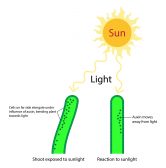Definition
noun, plural: photoropisms
Growth or movement response of a cell or an organism to light
Supplement
In general, tropism is an orienting response of an organism to a stimulus. It often involves the growth rather than the movement of an organism. The response exhibited by the organism to the stimulus is mostly involuntary, which means it cannot go either towards or away from the stimulus source as in taxis. In tropism, the response of the organism is often by its growth rather than by its movement. It may grow either towards or away from the stimulus.
Phototropism is the growth or movement response of a cell or an organism to light. The growth response may be positive or negative. A positive phototropism is when the growth of an organism is towards the source of light. A negative phototropism, also known as skototropism or scototropism, is when the organism tends to grow away from the source of light. The plant shoots and meristems, for instance, show positive phototropism. Plants are capable of responding to light in terms of growth with the help of different signaling molecules. According to Cholodny-Went hypothesis, in the presence of asymmetric light, auxin would move towards the shaded side and promote localized cell elongation to enable the plant to curve towards the light.1
Word origin: photo-, Ancient Greek phôs (“light”) + tropism
Compare:
- phototaxis
- photokinesis
- heliotropism
See also:
Reference(s):
1 Christie, J.M., and Murphy, A.S. (2013). Shoot phototropism in higher plants: New light through old concepts. American Journal of Botany 100(1), 35-46.



